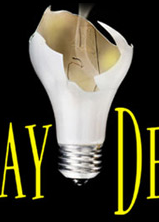The magician Todd Robbins eats light bulbs. For a while last year he practiced his brand of indigestitation in an off-Broadway show on magic and murder, Play Dead. Most of the production was in the tradition of Ricky Jay’s several one-man meditations on the history of hokum. The one exception came early in the show (since closed), when Robbins put a light bulb into his mouth, bit down, and kept biting down until the glass part of the bulb was gone. He asked a woman in one of the first rows if she believed that he’d really eaten the bulb. “No,” she said. He looked slightly crushed, then tried again: He really had eaten the bulb. Really! Now did she believe him? “No.”
I happened to know, through a mutual friend, that Robbins does eat light bulbs. There isn’t a trick to doing it, but there is a technique, and he’s mastered it. (It requires “eating the glass so that it is sufficiently masticated and pulverized to get through his system,” the show’s co-writer and director Teller, of Penn and Teller, told The Wall Street Journal). But how do you convince an audience watching a show full of illusions that the stranger-than-fiction thing they’ve just seen is real?
I’ve been thinking about that light bulb for the past few weeks, ever since I saw a trailer for Mission: Impossible—Ghost Protocol (who says the masses aren’t ready for esoteric, but correct, punctuation?). I watched Tom Cruise cling, katydid-style, to the side of a skyscraper, then rappel down, or up, or sideways, or something. Whatever it was he was doing, I knew he wasn’t doing it. Computer Generated Imagery (CGI) was doing it. Even if Tom Cruise himself sat down next to me in the movie theater and insisted that it was really him rappelling down the side of the skyscraper—really!—I wouldn’t have believed him.*
Yet I believe that humans are descended from primordial sludge, that “empty” space is filled with a quantum froth of virtual particles popping into and out of existence (or “existence”), that the universe is expanding, and that 96 percent of the mass-energy density of the universe is in a form that we as a species have never seen.
The difference between believability in show business and believability in science is context. Both Todd Robbins and Tom Cruise are in the business of illusions. The default assumption for their audiences is that everything is an illusion, so even when something isn’t, it still is—at least in the minds of the viewers. Robbins shouldn’t have been surprised that a woman in the audience didn’t believe he had eaten a light bulb; Cruise would be shocked if he heard that someone did believe he could rappel down a skyscraper.*
Conversely, scientists are in the business of reality. The default assumption for a nonscientist like myself, and presumably for the readers of this site, is that everything they say is real, is real. I don’t mean a single result like the faster-than-light neutrino finding last year; one data point might be tantalizing in its implications, but that’s not the same as being believable. For believability, we nonscientists have to wait for the consensus of the scientific community. Just as CGI experts work together to try to make an onscreen illusion as real-looking as possible, so scientists work together to try to ensure that a result is illusion-free. They try to find where they might be fooling themselves, and then they try some more, and then they try some more. And when enough scientists have failed at finding an error, and instead have found a consistently close match between hypothesis and observation, a conclusion becomes increasingly compelling: The result is real.
That reality isn’t irrefutable. Evidence that falsifies the theory might still emerge. If it does, the community has to reconsider the hypothesis, and if further falsifying evidence emerges, the community has to reject the hypothesis and concede that the earlier result was an illusion after all. Nature has been known to play tricks. Magicians have been known to eat light bulbs.
This contrast between show business and science might illuminate the thinking of knee-jerk science skeptics. Climate-change deniers, Biblical literalists, Intelligent Design advocates are not working from the same default assumption as you and I. For them, the given is that science operates like show business. I’m not saying that for skeptics everything in science is an illusion, but that they often see science not as a competition to prove the other guy wrong, but as a collusion. For them, scientists are like special effects artists working together to make Tom Cruise airborne.
For us, the opposite is true. Take away the competition among scientists and we would be stuck with illusions, just like taking away the special effects artists leaves us blessed with this: Buster Keaton performing his own stunts (especially the part beginning at 1:14).
* In a Comment below, a reader has kindly (and, thankfully, non-mockingly) pointed out that Tom Cruise actually performed the katydid-on-a-skyscraper stunt (albeit with some CGI help), and she has embedded a video. Which I guess means I’m like the lightbulb skeptic at the performance of Play Dead. Which maybe even reinforces the larger point of the essay. In any case, I should have fact-checked even the seemingly impossible, just as I was taught in journalism school, and I apologize for not doing so. And if Tom Cruise ever does sit down next to me in a movie theater and insist he did a stunt himself, I’m giving him the benefit of the doubt. (Though not the faster-than-light neutrino folks.)
* * *

All of the UAE knows that Tom did it:
http://www.youtube.com/watch?v=Y_-blkp5MbQ&feature=related
;.)
Ugh. Thanks, Michele. Please see just-added footnote above. [Smiling-through-gritted-teeth emoticon]
I couldn’t even watch that video to the end. I hardly still believe it.